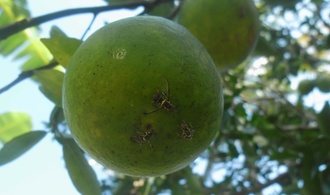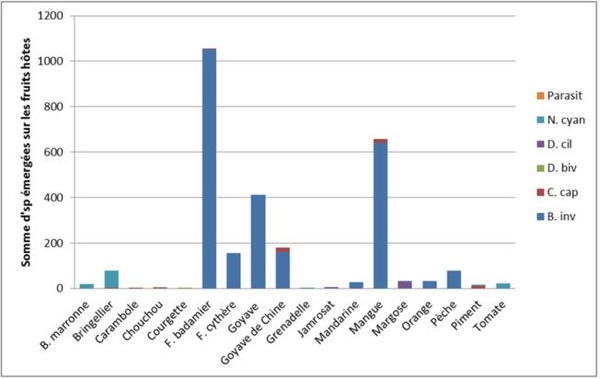The battle against fruit flies continues in the Comoros
Written by Modified on the
The fruit fly Bactrocera invadens (or dorsalis) was detected in 2005 in the Comoros archipelago and poses a considerable threat to fruit crops there. To control this pest, a biological control program was launched in 2013.
This program, part of the thesis of entomologist Issa Mze Hassani, will examine the behavior of species of fruit flies in order to prepare for the introduction of one of its natural enemies, the tiny wasp Fopius arisanus. Here we present the interim results.
Reintroducing a natural enemy to control the fruit fly populations
To reduce the devastation caused by fruit flies on fruit crops in the Comoros, a biological control program was launched in 2013[1] as part of the ePRPV program[2]. It aims to better understand the biology and ecology of Tephritidae (fruit fly family) present in the archipelago in order to prepare for the introduction of one of their natural enemies, a tiny wasp called Fopius arisanus. When the fruit fly enters a new territory, often through imported plants and plant-related products, they quickly multiply due to the absence of their natural predators.
F. arisanus is a parasitoid; it kills the host it infects. It is therefore used as an “auxiliary” to control fruit fly numbers as part of a sustainable farming program. The wasp was imported from Hawaii to Reunion Island in 2003, where studies conducted by CIRAD[3] helped to turn it into an effective biological control agent. The wasp is unspecialized and will attack all species of fruit fly at a variable rate of parasitism of up to 70-80% under favorable climatic conditions and depending on the type of host plants. To prepare for the introduction of F. arisanus to the Comoros archipelago, the ecological conditions necessary for the development of fruit flies must be understood.
This work is conducted by entomologist Issa Mze Hassani as part of his thesis, carried out with the PVBMT Joint Research Unit[4] in partnership with INRAPE[5]. They have created a surveillance and prevention network across the archipelago, with several sites located in Grande Comore, Anjouan and Moheli, where fruit flies are monitored weekly in an orchard setting.
Understanding fruit fly's host plants and seasonal fluctuations
The study has three main objectives. The first was to identify, map and define the range of host plants for fruit fly species in the three islands of the Comoros archipelago. To this end, sampling was carried out via trapping using sex and food attractants from 2013 to 2015. In addition, 170 samples comprising 40 cultivated or wild fruits and vegetables were sampled from the three islands, especially Grande-Comore.
The results highlight the presence of Bactrocera invadens, also known as B. dorsalis, on all the islands of the archipelago. As for host plants, the highest density of pests is found on the Badamier tree, a plant reservoir that allows the species to multiply. Of the cultivated plants, guava, Chinese guava, mango and cythère - known as sakoua in the Comoros or Zevi in Réunion - are the most affected. Ceratitis capitata, also known as the Mediterranean fruit fly, was found in much smaller numbers on Chinese guava, mango and chilli. Other fruit fly species have been described anecdotally.
The second step was to study the distribution and seasonal fluctuations in populations of different species of fruit flies based on climatic variables. Initial results show that the highest population densities are observed during the hot, rainy season, mainly in Grande Comore.
Inventory of fruit flies’ natural enemies and releases of parasitoids
The final step of the study was to identify the natural enemies, parasitoids and predators of fruit flies and to assess their impact on pest populations. Fifteen targeted sample collections have been carried out since the beginning of 2015. Initial results show predation of fruit fly pupae at ground level without parasitoids emergence. Active predators, including beetles and ants, were identified using "Pitfall" traps.
In addition, from November 2013 to November 2014, four releases of F. arisanus took place around Moroni using 200 to 250 individuals per site. This unfortunately did not led to the emergence of the parasitoid after the collection of the tropical Badamier fruit, which suggests that it has not yet acclimatized to the archipelago. New releases will take place in mid- and late 2015 using cocoons from UMR PVBMT farms in Reunion Island. Fruit collection and trapping will continue to monitor the acclimatization of the parasitoid and changes in fruit fly populations.
Researchers plan to extend this program to other Indian Ocean islands. Bear in mind that B. invadens was detected in the Seychelles in 2006, Mayotte in 2007[6], Madagascar in 2010 and in Mauritius in March 2013[7]. Reunion Island is currently free of the pest.
To find out more (in French):
- A biological control program against the fruit fly Bactrocera invadens in the Comoros;
- Issa Mze Hassani, INRAPE entomologist: "There is a lot of work to do in pest control in the Comoros";
- Understanding fruitflies to control them;
- Control methods against Bactrocera invadens;
- Fruitflies: what do we know about these pests?
- Combining methods, on the field and the island, to reduce fruit fly populations.
[1] A biological control program against the fruit fly Bactrocera invadens in Comoros.
[2] Enlargement and sustainability of the Plant Protection Program - www.e-prpv.org
[3] Fopius arisanus, le droit à l'erreur : spécificité parasitaire et sélection de l'hôte chez un parasitoïde ovo-pupal de mouches des fruits Tephritidae = Fopius arisanus - publications.cirad.fr/une_notice.php?dk=540359 Rousse P.. 2007. Saint-Denis : Université de La Réunion, 298 p.. Thèse de doctorat -- Biologie animale.
[4] Unité Mixte de Recherche (UMR) Peuplements Végétaux et Bio-agresseurs en Milieu Tropical (PVBMT) - www.umr-pvbmt.cirad.fr
[5] Institut National de Recherche pour l’Agriculture, la Pêche et l’Environnement des Comores.
[6] The fruit fly Bactrocera invadens detected in Mayotte!
[7] The fruit fly Bactrocera invadens / dorsalis in Mauritius.


